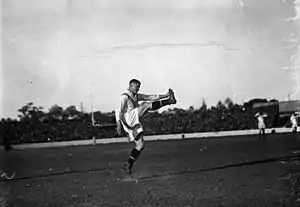Field goal (rugby)
A field goal, also called a flying kick[1] or speculator, was a way of scoring in the game of rugby football. It consisted of a player kicking the ball from the ground (not on a kicking tee) without using their hands in open play over the crossbar. This method of scoring was abolished in rugby union in 1905 and in rugby league in 1950.

Rugby union
During the development of rugby football, the field goal was considered a legitimate way of scoring. In 1845, place kicks were the only way to score a goal. In 1871, it was clarified under Law 6 that kicking the ball through the posts from the ground in open play was a valid method of scoring a goal.[2] A rejected proposal in 1882 by the Rugby Football Union suggested that field goals, referred to as a "flying kick", would be worth 4 points, the same value as a try.[3] It was eventually formalised in 1891 by the International Rugby Football Board that field goals (classed as any other goals) would be worth 4 points.[3][4] However, in 1905 both the IRFB and Rugby Football Union (RFU) abolished the field goal as a valid method of scoring.[3]
Rugby league
When the Northern Rugby Football Union broke away from the RFU, both codes' governing bodies retained the field goal. While the RFU abolished the field goal in rugby union in 1905, rugby league retained it. However, there was criticism about it on the 1908–09 Australia rugby league tour of Britain, whereby the Australia national rugby league team player Dally Messenger continuously and recklessly attempted field goals during a match against the England national rugby league team.[5] A writer for the Daily Chronicle stated: "I do not believe in the speculator at any time, it is bad rugby football", and expressed concern that Dally would either injure himself or others.[5] As predicted, during a later match against St. Helens, he damaged the cartilage in his knee due to repeated attempts at the scoring move.[5]
In 1922, the New South Wales Rugby Football League abolished the field goal along with the goal from mark.[6] However the Northern Rugby Football League, considered the guardian of the rules of rugby league at the time, kept the method in the rulebook, not officially abolishing it until 1950.[7] In Australia, the term field goal is used as a synonym for drop goal.[8]
See also
References
- Roodt, Gerhard (2015). The DNA of Rugby Football: A Short History of the Origin of Rugby Football. Partridge Africa. ISBN 978-1482808292.
- Smith, Jed (2011). The Original Rules Of Rugby. Penguin UK. ISBN 978-0857962980.
- "Scoring". Rugby Football History. Retrieved 2017-03-14.
- "06 Jun 1905 – RUGBY". The Daily News. Perth. 1905-06-06. Retrieved 2017-03-14 – via National Library of Australia.
- Fagan, Sean (2011). "A mixture of racehorse and steamroller". The Master: The life and times of Dally Messenger Australia's first sporting superstar. Hatchette UK. ISBN 978-0733628993.
- "Some interesting rule changes over the years". NRL South East Queensland. Retrieved 2017-03-14.
- "The Development of British Rugby League". Wakefield Trinity Wildcats. Retrieved 2017-03-14.
- Rugby League (2015-04-07). "Field goal rule needs to be changed after calamitous ending to Bulldogs-Rabbitohs match". Sydney Morning Herald. Retrieved 2017-03-14.